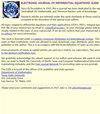非线性薛定谔系统的节点解
IF 0.8
4区 数学
Q2 MATHEMATICS
引用次数: 0
摘要
在本文中,我们考虑了非线性薛定谔系统 $$\displaylines{ - \Delta u_j + \lambda_j u_j = \sum_{i=1}^k \beta_{ij} u_i^2 u_j, \quad \hbox{in }\Omega, \cr u_j ( x ) = 0,\quad \hbox{on }.\Omega, \cr u_j ( x ) = 0,\quad \hbox{on }\partial \Omega ,\;j=1,l\dots,k , }$$ 其中 \(\Omega\subset \mathbb{R}^N \) (\(N=2,3\)) 是一个有界的光滑域, \(\lambda_j> 0\), \(j=1、\(beta_{jj}>0),(beta_{ij}=beta_{ji}/leq 0\) for\(1\leq i< j\leq k\).符号变化解的存在性是通过截断法和降流不变集法证明的。更多信息见 https://ejde.math.txstate.edu/Volumes/2024/31/abstr.html本文章由计算机程序翻译,如有差异,请以英文原文为准。
Nodal solutions for nonlinear Schrodinger systems
In this article we consider the nonlinear Schrodinger system $$\displaylines{ - \Delta u_j + \lambda_j u_j = \sum_{i=1}^k \beta_{ij} u_i^2 u_j, \quad \hbox{in } \Omega, \cr u_j ( x ) = 0,\quad \hbox{on } \partial \Omega , \; j=1,l\dots,k , }$$ where \(\Omega\subset \mathbb{R}^N \) (\(N=2,3\)) is a bounded smooth domain, \(\lambda_j> 0\), \(j=1,\ldots,k\), \(\beta_{ij}\) are constants satisfying \(\beta_{jj}>0\), \(\beta_{ij}=\beta_{ji}\leq 0 \) for \(1\leq i< j\leq k\). The existence of sign-changing solutions is proved by the truncation method and the invariant sets of descending flow method.
For more information see https://ejde.math.txstate.edu/Volumes/2024/31/abstr.html
求助全文
通过发布文献求助,成功后即可免费获取论文全文。
去求助
来源期刊

Electronic Journal of Differential Equations
MATHEMATICS, APPLIED-MATHEMATICS
CiteScore
1.50
自引率
14.30%
发文量
1
审稿时长
3 months
期刊介绍:
All topics on differential equations and their applications (ODEs, PDEs, integral equations, delay equations, functional differential equations, etc.) will be considered for publication in Electronic Journal of Differential Equations.
 求助内容:
求助内容: 应助结果提醒方式:
应助结果提醒方式:


